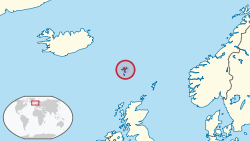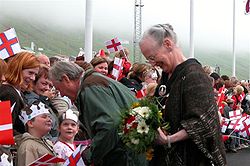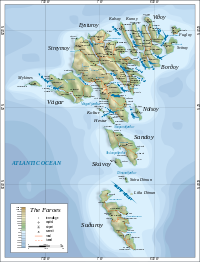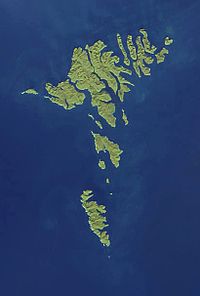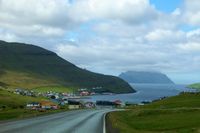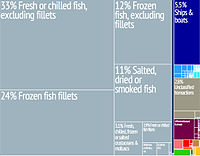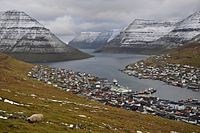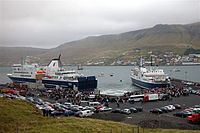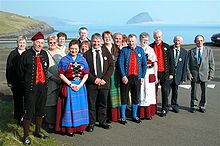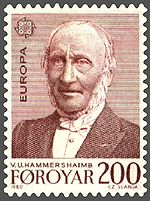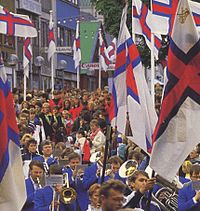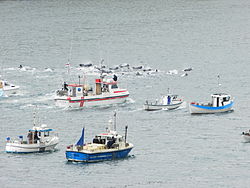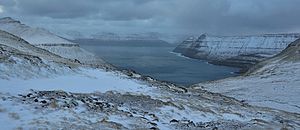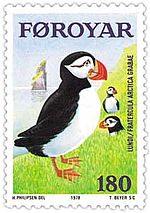
Faroe Islands
About this schools Wikipedia selection
SOS Children made this Wikipedia selection alongside other schools resources. SOS Child sponsorship is cool!
Coordinates: 62°00′N 06°47′W
Faroe Islands
|
||||||
|---|---|---|---|---|---|---|
|
||||||
| Anthem: Tú alfagra land mítt Thou, my most beauteous land |
||||||
|
Location of the Faroe Islands in Northern Europe.
|
||||||
| Capital and largest city |
Tórshavn 62°00′N 06°47′W |
|||||
| Official languages |
|
|||||
| Ethnic groups |
|
|||||
| Demonym | Faroese | |||||
| Government | Parliamentary democracy under constitutional monarchy | |||||
| - | Queen | Margrethe II | ||||
| - | High Commissioner | Dan M. Knudsen | ||||
| - | Prime Minister | Kaj Leo Johannesen | ||||
| Legislature | Løgting | |||||
| Autonomy within the Kingdom of Denmark | ||||||
| - | Unified with Norway | 1035 | ||||
| - | Ceded to Denmark | 14 January 1814 | ||||
| - | Home rule | 1 April 1948 | ||||
| Area | ||||||
| - | Total | 1,399 km2 ( 180th) 540 sq mi |
||||
| - | Water (%) | 0.5 | ||||
| Population | ||||||
| - | July 2011 estimate | 49,267 ( 206th) | ||||
| - | 2011 census | 48,351 | ||||
| - | Density | 35/km2 91/sq mi |
||||
| GDP ( PPP) | 2008 estimate | |||||
| - | Total | $1.642 billion | ||||
| - | Per capita | $33,700 | ||||
| GDP (nominal) | 2008 estimate | |||||
| - | Total | $2.45 billion | ||||
| - | Per capita | $50,300 | ||||
| HDI (2011) | 0.895 very high |
|||||
| Currency | Faroese króna ( DKK) |
|||||
| Time zone | WET ( UTC+0) | |||||
| - | Summer ( DST) | WEST ( UTC+1) | ||||
| Calling code | +298 | |||||
| ISO 3166 code | FO | |||||
| Internet TLD | .fo | |||||
| a. | ^ Danish monarchy reached the Faeroes in 1380 with the reign of Olav IV of Norway. | |||||
| b. | ^ The Faeroes, Greenland and Iceland were formally Norwegian possessions until 1814, as Norway was united with Denmark. | |||||
| c. | ^ Information for Denmark including the Faroe Islands and Greenland. | |||||
| d. | ^ The currency, printed with Faroese motifs, is issued at par with the Danish krone, uses the same sizes and standards as Danish coins and banknotes and incorporates the same security features. Faroese krónur (singular króna) share the Danish ISO 4217 code "DKK". | |||||
The Faroe Islands ( / ˈ f ɛ ə r oʊ /; Faroese: Føroyar pronounced [ˈfœɹjaɹ]; Danish: Færøerne Danish pronunciation: [ˈfæɐ̯øːˀɐnə]) are an island group and archipelago under the sovereignty of the Kingdom of Denmark, situated between the Norwegian Sea and the North Atlantic Ocean, approximately halfway between Norway and Iceland. The total area is approximately 1,400 km2 (540 sq mi) with a 2010 population of almost 50,000 people.
The Faroe Islands have been a self-governing country within the Danish Realm since 1948. Over the years, the Faroese have taken control of most domestic matters. Areas that remain the responsibility of Denmark include military defence, police, justice, currency and foreign affairs. The Faroe Islands also has representatives in the Nordic Council as members of the Danish delegation.
The islands were associated with and taxed by Norway, then the Union of Kalmar, and then Denmark-Norway until 1814, when Norway was united with Sweden. Scandinavia was in political turmoil following the Sixth Coalition of the Napoleonic Wars, when the Treaty of Kiel granted Denmark control over the Faroes, Iceland and Greenland in 1814. The Danish trade monopoly ended in 1856.
History
It seems that Scottish and Irish hermits and monks from a Hiberno-Scottish mission lived in the Faroes in the 6th century, speaking Old Irish (alt. Old Gaelic). It is claimed that Saint Brendan, an Irish monastic saint who lived around 484–578, visited the Faroe Islands on two or three occasions (512–530), but the identification is by no means certain. It is claimed that two of the islands, called Sheep Island and Paradise Island of Birds, were named by him. It has long been speculated that Irish monks may have migrated north to the Faroe Islands long before the Vikings arrived, but despite the efforts of many scientists nothing has yet been found which can prove that people lived on the Faroe Islands before around 800AD, although scientists from Aberdeen University found early cereal pollen samples on the islands, which suggests people may have lived on the islands before the Vikings arrived.
Later on (c. 800) Norsemen settled the islands, bringing the Old Norse language that has evolved into the modern Faroese language spoken today. According to the Icelandic Sagas such as Færeyjar Saga one of the best known men in ancient Faroes is Tróndur í Gøtu, who was descended from some of the Scandinavian war chiefs who settled in Dublin, Ireland. Tróndur led the battle against Sigmund Brestursson, the Norwegian monarchy and the Norwegian church.
These settlers are not thought to have come directly from Scandinavia, but rather from Norse communities surrounding the Irish Sea, Northern Isles and Western Isles of Scotland, including the Shetland and Orkney islands, and Norse-Gaels. The old Gaelic name for the Faroe Islands, Na Scigirí, means the Skeggjar and probably refers to the Eyja-Skeggjar (Island-Beards), a nickname given to the island dwellers. The aforementioned theories are speculative and are not supported by archeological evidence. However, the immigration of Norwegian Vikings is well documented. Thus, according to the Faroe Islands Government, the Nordic language and culture are derived from the Norwegians, or Norsemen, who settled in the Faroe Islands.
According to Færeyinga Saga, emigrants left Norway who didn't approve of the monarchy of Harald I of Norway. These people settled the Faroes around the end of the 9th century. Early in the 11th century, Sigmundur Brestirson – whose clan had flourished in the southern islands but had been almost exterminated by invaders from the northern islands – escaped to Norway. He was sent back to take possession of the islands for Olaf Tryggvason, King of Norway. Sigmundur introduced Christianity, forcing Tróndur í Gøtu to convert or face beheading and, though he was subsequently murdered, Norwegian taxation was upheld. Norwegian control of the Faroes continued until 1814, although, when Norway entered the Kalmar Union with Denmark, it gradually resulted in Danish control of the islands. The Reformation reached the Faroes in 1538. When the union between Denmark and Norway was dissolved as a result of the Treaty of Kiel in 1814, Denmark retained possession of the Faroe Islands.
The trade monopoly in the Faroe Islands was abolished in 1856, after which the area developed as a modern fishing nation with its own fleet. The national awakening since 1888 was initially based on a struggle to maintain the Faroese language and was thus culturally oriented, but after 1906 it became politically oriented, with the foundation of political parties of the Faroe Islands.
On 12 April 1940, the Faroes were occupied by British troops. The move followed the invasion of Denmark by Nazi Germany and had the objective of strengthening British control of the North Atlantic (see Battle of the Atlantic). In 1942–1943 the British Royal Engineers built the only airport in the Faroes, Vágar Airport. Control of the islands reverted to Denmark following the war, but in 1948 home-rule was introduced, with a high degree of local autonomy. In 1973 the Faroe Islands declined to join Denmark in entering the European Community (now European Union). The islands experienced considerable economic difficulties following the collapse of the fishing industry in the early 1990s, but have since made efforts to diversify the economy. Support for independence has grown and is the objective of the Republican Party.
Politics
The Faroese government holds executive power in local government affairs. The head of the government is called the Løgmaður ("Law person") and serves as a prime minister. Any other member of the cabinet is called a landsstýrismaður ("national committee man") or landsstýriskvinna ("national committee woman"). The Faroese parliament – the Løgting ("Law assembly") – dates back to Viking times and is believed to be one of the oldest parliaments in the world.
Today, elections are held at municipal, national and Danish ( Folketing) levels. Until 2007, there were seven electoral districts, each comprising a sýsla, while Streymoy was divided into a northern and southern part ( Tórshavn region). However, on 25 October 2007, changes were made such that the entire country is one electoral district, giving each vote equal weight.
Relationship with Denmark
The Faroe Islands have been under Danish control since 1388. The 1814 Treaty of Kiel terminated the Danish-Norwegian union, and Norway came under the rule of the King of Sweden, while the Faroe Islands, Iceland, and Greenland remained Danish possessions. The Løgting was abolished in 1816, and the Faroe Islands were to be governed as an ordinary Danish amt (county), with the Amtmand as its head of government. In 1851, the Løgting was reinstated, but, until 1948, served mainly as an advisory body.
At the end of World War II, some of the population favored independence from Denmark, and on 14 September 1946 an independence referendum was held on the question of secession. It was a consultative referendum; the parliament was not bound to follow the people's vote. This was the first time that the Faroese people had been asked whether they favored independence or wanted to continue within the Danish kingdom. The result of the vote was a narrow majority in favour of secession, but the coalition in parliament could not reach agreement on how this outcome should be interpreted and implemented; and because of these irresoluble differences, the coalition fell apart. A parliamentary election was held a few months later, in which the political parties that favored staying in the Danish kingdom increased their share of the vote and formed a coalition. Based on this, they chose to reject secession. Instead, a compromise was made and the Folketing passed a home-rule law that went into effect in 1948. The Faroe Islands' status as a Danish amt was thereby brought to an end; the Faroe Islands were given a high degree of self-governance, supported by a financial subsidy from Denmark to recompense expenses the Islands have on Danish services.
At present, the islanders are about evenly split between those favoring independence and those who prefer to continue as a part of the Kingdom of Denmark. Within both camps there is a wide range of opinions. Of those who favor independence, some are in favour of an immediate unilateral declaration of independence. Others see it as something to be attained gradually and with the full consent of the Danish government and the Danish nation. In the unionist camp there are also many who foresee and welcome a gradual increase in autonomy even while strong ties with Denmark are maintained.
In 2011, a new draft Faroese constitution is being drawn up. However the draft has been declared by the former Danish Prime Minister, Lars Løkke Rasmussen, as incompatible with Denmark's constitution and if the Faroese political parties wish to continue with it then they must declare independence.
Relationship with the European Union
As explicitly asserted by both EU treaties, the Faroe Islands are not part of the European Union. Moreover, a protocol to the treaty of accession of Denmark to the European Communities stipulates that Danish nationals residing in the Faroe Islands are not to be considered as Danish nationals within the meaning of the treaties. Hence, Danish people living in the Faroes are not citizens of the European Union (although other EU nationals living there remain EU citizens). The Faroes are not covered by the Schengen free movement agreement, but there are no border checks when travelling between the Faroes and any Schengen country. (The Faroes have been part of the Nordic Passport Union since 1966, and since 2001 there have been no border checks between the Nordic countries and the rest of the Schengen area as part of the Schengen agreement.)
Regions and municipalities
Administratively, the islands are divided into 30 municipalities (kommunur) within which there are 120 or so settlements.
Traditionally, there are also the six sýslur ("regions": Norðoyar, Eysturoy, Streymoy, Vágar, Sandoy and Suðuroy). Although today sýsla technically means "police district", the term is still commonly used to indicate a geographical region. In earlier times, each sýsla had its own ting (assembly), the so-called várting ("spring assembly").
Geography
The Faroe Islands are an island group consisting of 18 major islands about 655 kilometres (407 mi) off the coast of Northern Europe, between the Norwegian Sea and the North Atlantic Ocean, about halfway between Iceland and Norway, the closest neighbours being the Northern and Western Isles of Scotland. Its coordinates are 62°00′N 06°47′W.
The islands cover an area of 1,399 square kilometres (540 sq. mi) and it has no major lakes or rivers. There are 1,117 kilometres (694 mi) of coastline. The only significant uninhabited island is Lítla Dímun.
The islands are rugged and rocky with some low peaks; the coasts are mostly cliffs. The highest point is Slættaratindur, 882 metres (2,894 ft) above sea level.
The Faroe Islands are dominated by tholeiitic basalt lava, which was part of the great Thulean Plateau during the Paleogene period.
Distances to nearest countries and islands
- North Rona, Scotland (uninhabited): 260 kilometres (160 mi)
- Shetland ( Foula) (Scotland): 285 kilometres (177 mi)
- Orkney ( Westray) (Scotland): 300 kilometres (190 mi)
- Mainland Scotland: 320 kilometres (200 mi)
- Iceland: 450 kilometres (280 mi)
- Ireland: 670 kilometres (420 mi)
- Denmark: 990 kilometres (620 mi)
Economy
Economic troubles caused by a collapse of the Faroese fishing industry in the early 1990s brought high unemployment rates of 10 to 15% by the mid-1990s. Unemployment decreased in the later 1990s, down to about 6% at the end of 1998. By June 2008 unemployment had declined to 1.1%, before rising to 3.4% in early 2009. Nevertheless, the almost total dependence on fishing and fish farming means that the economy remains vulnerable. Petroleum found close to the Faroese area gives hope for deposits in the immediate area, which may provide a basis for sustained economic prosperity.
11.7% of Faroe Islands' national budget comes as economic aid from Denmark, which is about the same as 18% of Faroe Islands' total expense budget.
Since 2000, new information technology and business projects have been fostered in the Faroe Islands to attract new investment. The introduction of Burger King in Tórshavn was widely publicized and a sign of the globalization of Faroese culture. It is not yet known whether these projects will succeed in broadening the islands' economic base. The islands have one of the lowest unemployment rates in Europe, but this should not necessarily be taken as a sign of a recovering economy, as many young students move to Denmark and other countries after leaving high school. This leaves a largely middle-aged and elderly population that may lack the skills and knowledge to fill newly developed positions on the Faroes. In 2008 the Faroes made a $52 million loan to Iceland, in light of that country's banking woes.
On 5 August 2009, two opposition parties introduced a bill in the Løgting to adopt the Euro as the national currency, pending a referendum.
Transport
Vágar Airport has scheduled services from Vágar Island. The largest Faroese airline is Atlantic Airways.
Due to the rocky terrain and relatively small size of the Faroe Islands, its transport system was not as extensive as in other places of the world. This situation has now changed, and the infrastructure has been developed extensively. Some 80% of the population of the islands is connected by tunnels through the mountains and between the islands, bridges and causeways that link the three largest islands and three other large islands to the northeast together, while the other two large islands to the south of the main area are connected to the main area with new fast ferries. There are good roads to every village in the islands, except for seven of the smaller islands, six of which only have one village.
Demographics
The vast majority of the population are ethnic Faroese, of Norse and Scottish descent.
Recent DNA analyses have revealed that Y chromosomes, tracing male descent, are 87% Scandinavian. The studies show that mitochondrial DNA, tracing female descent, is 84% Scottish.
Of the approximately 48,500 inhabitants of the Faroe Islands (16,921 private households (2004)), Faroese are 91.7%, Danes 5.8%, Greenlanders 0.3%. The largest group of foreigners is Danes, comprising 5.8%, followed by Greenlanders, Icelanders, Norwegians and Poles. The Faroe Islands have people consisting of 77 different nationalities.
Faroese is spoken in the entire area as a first language. It is difficult to say exactly how many people worldwide speak the Faroese language, as many ethnic Faroese live in Denmark, and few who are born there return to the Faroes with their parents or as adults.
The Faroese language is one of the smallest of the Germanic languages. Written Faroese (grammar and vocabulary) are most similar to Icelandic and to their ancestor Old Norse, though the spoken language is closer to Norwegian dialects of the west coast of Norway. While Faroese is the main language in the islands, both Faroese and Danish are official languages.
Faroese language policy provides for the active creation of new terms in Faroese suitable for modern life.
Population trends (1327–2004)
If the first inhabitants of the Faroe Islands were Irish monks, then they must have lived as a very small group of settlers. Later, when the Vikings colonised the islands, there was a considerable increase in the population. However, it never exceeded 5,000 until the 18th century. Around 1349, about half the population perished in the Black Death plague.
Only with the rise of the deep-sea fishery (and thus independence from agriculture in the islands' harsh terrain) and with general progress in the health service was rapid population growth possible in the Faroes. Beginning in the 18th century, the population increased tenfold in 200 years.
At the beginning of the 1990s the Faroe Islands entered a deep economic crisis leading to heavy emigration; however, this trend reversed in subsequent years to a net immigration.
|
|
Urbanisation and regionalisation
The Faroese population is spread across most of the area; it was not until recent decades that significant urbanisation occurred. Industrialisation has been remarkably decentralised, and the area has therefore maintained quite a viable rural culture. Nevertheless, villages with poor harbour facilities have been the losers in the development from agriculture to fishing, and in the most peripheral agricultural areas, also known as the outer islands, there are few young people. In recent decades, the village-based social structure has nevertheless been placed under pressure, giving way to a rise in interconnected "centres" that are better able to provide goods and services than the badly connected periphery. This means that shops and services are now relocating en masse from the villages into the centres, and slowly but steadily the Faroese population is concentrating in and around the centres.
In the 1990s, the old national policy of developing the villages (Bygdamenning) was abandoned, and instead the government started a process of regional development (Økismenning). The term "region" referred to the large islands of the Faroes. Nevertheless the government was unable to press through the structural reform of merging the small rural municipalities in order to create sustainable, decentralised entities that could drive forward regional development. As regional development has been difficult on the administrative level, the government has instead made heavy investment in infrastructure, interconnecting the regions.
In general, it is becoming less valid to regard the Faroes as a society based on separate islands and regions. The huge investments in roads, bridges and sub-sea tunnels (see also Transport in the Faroe Islands) have bound the islands together, creating a coherent economic and cultural sphere that covers almost 90% of the population. From this perspective it is reasonable to regard the Faroes as a dispersed city or even to refer to it as the Faroese Network City.
Religion
According to the Færeyinga Saga, Sigmundur Brestisson brought Christianity to the islands in 999. However, archaeology at a site in Leirvík suggests that Celtic Christianity may have arrived at least 150 years earlier. The Faroe Islands' Church Reformation was completed on 1 January 1540. According to official statistics from 2002, 84.1% of the Faroese population are members of the state church, the Faroese People's Church (Fólkakirkjan), a form of Lutheranism. The Fólkakirkjan became an independent church in 2007; previously it had been a diocese within the Church of Denmark. Faroese members of the clergy who have had historical importance include V. U. Hammershaimb (1819–1909), Frederik Petersen (1853–1917) and, perhaps most significantly, Jákup Dahl (1878–1944), who had a great influence in ensuring that the Faroese language was spoken in the church instead of Danish. Participation in churches is more prevalent among the Faroese population than among most other Scandinavians.
In the late 1820s, the Christian Evangelical religious movement, the Plymouth Brethren, was established in England. In 1865, a member of this movement, William Gibson Sloan, travelled to the Faroes from Shetland. At the turn of the 20th century, the Faroese Plymouth Brethren numbered thirty. Today, approximately 10% of the Faroese population are members of the Open Brethren community (Brøðrasamkoman). Approximately 3% belong to the charismatic movement, which started somewhere late around 1920s, but had their golden days in 1970s–1980s. There are several charismatic churches around the islands, the largest of which, called Keldan (Spring Water), congregation (approximately 200 to 300 members). About 2% belong to other Christian groups. The Adventists operate a private school in Tórshavn. Jehovah's Witnesses also number four congregations with a total of 118 members. The Roman Catholic congregation comprises approximately 170 members. The municipality of Tórshavn has an old Franciscan school. There are also around fifteen Bahá'ís who meet at four different places. The Ahmadiyya Muslim Community was established in the Faroe Islands in 2010. Unlike Denmark, Sweden, and Iceland with Forn Siðr, the Faroes have no organised Ásatrú community, but there is a fair share of pagan lore, song and ritual performed in individuals' houses or in public spaces, rather than in church buildings.
The best-known church buildings in the Faroe Islands include Tórshavn Cathedral, St. Olaf's Church, and the Magnus Cathedral in Kirkjubøur; the Vesturkirkjan and the Maria Church, both of which are situated in Tórshavn; the church of Fámjin; the octagonal church in Haldarsvík; Christianskirkjan in Klaksvík; and also the two pictured here.
In 1948, Victor Danielsen (Plymouth Brethren) completed the first Bible translation into Faroese from different modern languages. Jacob Dahl and Kristian Osvald Viderø (Fólkakirkjan) completed the second translation in 1961. The latter was translated from the original Biblical languages (Hebrew and Greek) into Faroese.
Culture
The culture of the Faroe Islands has its roots in the Nordic culture. The Faroe Islands were long isolated from the main cultural phases and movements that swept across parts of Europe. This means that they have maintained a great part of their traditional culture. The language spoken is Faroese and it is one of three insular Scandinavian languages descended from the Old Norse language spoken in Scandinavia in the Viking Age, the others being Icelandic and the extinct Norn, which is thought to have been mutually intelligible with Faroese. Until the 15th century, Faroese had a similar orthography to Icelandic and Norwegian, but after the Reformation in 1538, the ruling Danes outlawed its use in schools, churches and official documents. Although a rich spoken tradition survived, for 300 years the language was not written down. This means that all poems and stories were handed down orally. These works were split into the following divisions: sagnir (historical), ævintýr (stories) and kvæði (ballads), often set to music and the mediaeval chain dance. These were eventually written down in the 19th century.
Ólavsøka
The national holiday, Ólavsøka, is on 29 July, and commemorates the death of Saint Olaf. The celebrations are held in Tórshavn, starting on the evening of the 28th and continuing until the 31st.
The official celebration starts on the 29th, with the opening of the Faroese Parliament, a custom that dates back 900 years. This begins with a service held in Tórshavn Cathedral; all members of parliament as well as civil and church officials walk to the cathedral in a procession. All of the parish ministers take turns giving the sermon. After the service, the procession returns to the parliament for the opening ceremony.
Other celebrations are marked by different kinds of sports competitions, the rowing competition (in Tórshavn Harbour) being the most popular, art exhibitions, pop concerts, and the famous Faroese dance. The celebrations have many facets, and only a few are mentioned here.
People also mark the occasion by wearing the national Faroese dress.
The Nordic House in the Faroe Islands
The Nordic House in the Faroe Islands ( Faroese: Norðurlandahúsið) is the most important cultural institution in the Faroes. Its aim is to support and promote Scandinavian and Faroese culture, locally and in the Nordic region. Erlendur Patursson (1913–1986), Faroese member of the Nordic Council, raised the idea of a Nordic cultural house in the Faroe Islands. A Nordic competition for architects was held in 1977, in which 158 architects participated. Winners were Ola Steen from Norway and Kolbrún Ragnarsdóttir from Iceland. By staying true to folklore, the architects built the Nordic House to resemble an enchanted hill of elves. The house opened in Tórshavn in 1983. The Nordic House is a cultural organization under the Nordic Council of Ministers. The Nordic House is run by a steering committee of eight, of whom three are Faroese and five from other Nordic countries. There is also a local advisory body of fifteen members, representing Faroese cultural organizations. The House is managed by a director appointed by the steering committee for a four-year term.
Faroese literature
Faroese literature in the traditional sense of the word has only really developed in the past 100–200 years. This is mainly because of the islands' isolation, and also because the Faroese language was not written down in a standardised format until 1890. The Danish language was also encouraged at the expense of Faroese. Nevertheless, the Faroes have produced several authors and poets.
Music
The Faroe Islands have an active music scene. The islands have their own symphony orchestra, the classical ensemble Aldubáran and many different choirs; the best-known being Havnarkórið. The best-known Faroese composers are Sunleif Rasmussen and Kristian Blak. Blak is also head of the record company Tutl.
The first Faroese opera was by Sunleif Rasmussen. It is entitled Í Óðamansgarði ( The Madman´s Garden) and was premiered on 12 October 2006 at the Nordic House. The opera is based on a short story by the writer William Heinesen.
Young Faroese musicians who have gained much popularity recently are Eivør (Eivør Pálsdóttir), Anna Katrin Egilstrøð, Annika av Matras, Lena (Lena Andersen), Teitur (Teitur Lassen), Høgni Reistrup, Høgni Lisberg, HEIÐRIK ( Heiðrik á Heygum), Guðrið Hansdóttir and Brandur Enni.
Well-known bands include Týr, Gestir, The Ghost, Boys In A Band, ORKA, 200, Grandma's Basement, SIC, and the former band Clickhaze.
The festival of contemporary and classical music, Summartónar, is held each summer. Large open-air music festivals for popular music with both local and international musicians participating are G! Festival in Gøta in July and Summarfestivalurin in Klaksvík in August.
Traditional food
Traditional Faroese food is mainly based on meat, seafood and potatoes and uses few fresh vegetables. Mutton is the basis of many meals, and one of the most popular treats is skerpikjøt, well aged, wind-dried mutton, which is quite chewy. The drying shed, known as a hjallur, is a standard feature in many Faroese homes, particularly in the small towns and villages. Other traditional foods are ræst kjøt (semi-dried mutton) and ræstur fiskur, matured fish. Another Faroese specialty is Grind og spik, pilot whale meat and blubber. (A parallel meat/fat dish made with offal is garnatálg.) Well into the last century, meat and blubber from a pilot whale meant food for a long time. Fresh fish also features strongly in the traditional local diet, as do seabirds, such as Faroese puffins, and their eggs. Dried fish is also commonly eaten.
There are two breweries in the Faroe Islands. The first brewery is called Föroya Bjór and has produced beer since 1888 with exports mainly to Iceland and Denmark. The second brewery is called Okkara and was founded in 2010. A local specialty is fredrikk, a special brew, made in Nólsoy. Production of hard alcohol such as snaps is forbidden in the Faroe Islands, hence the Faroese aqua vit, Aqua Vita, is produced abroad.
Since the friendly British occupation, the Faroese have been fond of British food, in particular fish and chips and British-style chocolate such as Cadbury Dairy Milk, which is found in many of the island's shops, whereas in Denmark this is scarce.
Whaling
There are records of drive hunts in the Islands dating from 1584. It is regulated by Faroese authorities but not by the International Whaling Commission as there are disagreements about the Commission's legal authority to regulate small cetacean hunts. Hundreds of long-finned pilot whales (Globicephala melaena) could be killed in a year, mainly during the summer. The hunts, called " grindadráp" in Faroese, are non-commercial and are organized on a community level; anyone can participate. The hunters first surround the pilot whales with a wide semicircle of boats. Then they drive the whales slowly into a bay or to the shallows of a fjord. When a whale is in shallow water a hook is placed in its blowhole so that it may be dragged ashore. Once on land or immobilized in knee-deep water, a cut is made across its top near the blowhole to partially sever its head. The dead animals are then dragged further to shore after the remaining whales have been likewise killed.
This "grindadráp" is legal and provides food for many people in the Faroe Islands.
Some Faroese consider the hunt an important part of their culture and history. Animal-rights groups, such as the Sea Shepherd Conservation Society, criticize it as being cruel and unnecessary, while the hunters claim in return that most journalists do not exhibit sufficient knowledge of the catch methods or its economic significance.
Sport
The Faroe Islands compete in the biennial Island Games, which were hosted by the islands in 1989. Ten football teams contest the Faroe Islands Premier League, currently ranked 51st by UEFA's League coefficient. The Faroe Islands are a full member of UEFA and the Faroe Islands national football team competes in the UEFA European Football Championship qualifiers. The country is also a full member of FIFA and therefore the Faroe Islands football team also competes in the FIFA World Cup qualifiers. The country won its first ever competitive match when the team defeated Austria 1–0 in a UEFA Euro 1990 qualifying. On 7 June 2011, the Faroe Islands secured their first competitive win in the UEFA European Championship qualifying rounds in 16 years, when they beat Estonia 2–0 in Toftir. The Faroe Islands compete in the Paralympics, but have yet to make an appearance in the Olympics, where they compete as part of Denmark.
Handcrafts
Faroese handicrafts are mainly based around materials available within local villages which is mainly wool. Products include jumpers, scarves and gloves. Faroese jumpers have distinct Nordic patterns with each village having some regional variations handed down from mother to daughter. There has recently been a strong revival and interest in Faroese knitting with young people knitting and wearing updated versions of old patterns emphasized by strong colours and bold patterns. This appears to be a reaction to the loss of traditional lifestyles and as a way to maintain and assert cultural tradition in a rapdily changing society. Many young people study and move abroad and this allows them to maintain cultural links which identifies their specific Faroese heritage.
There has also been a great interest in Faroese jumpers from the TV series The Killing, where the popular main actress wears a different Faroese jumper for each series (two so far). This has greatly increased the profile of the Faroe Islands, particularly within the fashion industry as jumpers are now sold in places such as Harrods.
Lace knitting is a traditional handicraft. The most distinctive trait of Faroese lace shawls is the centre back gusset shaping. Each shawl consists of two triangular side panels, a trapezoid-shaped back gusset, an edge treatment, and usually shoulder shaping. These are worn by all generations of women particularly in relation to the Traditional faroese costume as an over garment.
Faroese national dress
The traditional Faroese national dress is also a local handicraft which people spend a lot of time, money and effort to assemble. This is worn at weddings, traditional dancing events and on feast days. The cultural significance of the garment should not be under-estimated both as an expression of local and national identity and a passing on and re-enforcing of traditional skills that bind local communities together.
A young Faroese person is normally handed down a set of children`s Faroese clothes that is then passed from generation to generation. Child are confirmed at age 14 and normally start to collect the pieces to make an adult outfit which is considered as a rite of passage. Traditionally the aim would have been for the outfit to be completed by the time a young person was ready to marry and would have been worn at the ceremony, although it is mainly only men who do this now.
Each piece is intricately hand-knitted, dyed, woven, or embroidered to the specifications of the wearer. For example the male waistcoat is put together by hand in bright blue, red, or black fine wool. The front is then intricately embroided with colourful silk threads, often by a female relative. The motifs are often local Faroese flowers or herbs. After this, a row of Faroese made solid silver buttons are sewn on the outfit.
Women wear embroidered silk, cotton, or wool shawls and pinafores that can take months to weave or embroider with local flora and fauna. They are also adorned with a handwoven black and red ankle-length skirt, knitted black and red jumper, a velvet belt, and black 18th Century styke shoes with silver buckles. The outfit is held together by a row of solid silver buttons, silver chains and spectacular locally made silver broches and belt buckles, often fashioned with Viking style motifs.
Both men's and women's national dress are extremely costly and can take many years to assemble. Women in the family often work together to assemble the outfits, including knitting the close-fitting jumpers, weaving and embroidering, sewing and assembling the national dress.
This tradition binds together families, passes on traditional crafts, and re-enforces the Faroese culture of traditional village living within the context of a modern society.
Public holidays
- New Year's Day, 1 January.
- Maundy Thursday
- Good Friday
- Easter Sunday
- Easter Monday
- Flag day, 25 April.
- General/Great Prayer Day ( Dýri biðidagur), 4th Friday after Easter.
- Ascension Day
- Whit Sunday
- Whit Monday
- Constitution Day, 5 June (half-day holiday).
- St.Olav’s Eve, 28 July (half-day holiday).
- St.Olav’s Day, 29 July (national holiday).
- Christmas Eve, 24 December.
- Christmas Day, 25 December.
- Boxing Day, 26 December.
- New Year’s Eve, 31 December (half-day holiday).
Climate
The climate is classed as Maritime Subarctic according to the Köppen climate classification: Cfc. The overall character of the islands' climate is influenced by the strong warming influence of the Atlantic Ocean, which produces the North Atlantic Current. This, together with the remoteness of any source of warm airflows, ensures that winters are mild (mean temperature 3.0 to 4.0 °C or 37 to 39°F) while summers are cool (mean temperature 9.5 to 10.5 °C or 49 to 51°F).
The islands are windy, cloudy and cool throughout the year with over 260 annual rainy days. The islands lie in the path of depressions moving northeast and this means that strong winds and heavy rain are possible at all times of the year. Sunny days are rare and overcast days are common. Hurricane Faith struck the Faroe Islands on 5 September 1966 with sustained winds over 100 mph (160 km/h) and only then did the storm cease to be a tropical system.
The registration of meteorologic data on the Faroe Islands started in 1867.
Flora
The natural vegetation of the Faroe Islands is dominated by Arctic-alpine plants, wildflowers, grasses, moss and lichen. Most of the lowland area is grassland and some is heath, dominated by shrubby heathers, mainly Calluna vulgaris. Among the herbaceous flora that occur in the Faroe Islands is the cosmopolitan Marsh Thistle, Cirsium palustre.
Faroe is characterised by the lack of trees, resembling Connemara and Dingle in Ireland.
A few small plantations consisting of plants collected from similar climates such as Tierra del Fuego in South America and Alaska thrive on the islands.
Fauna
Birds
The bird fauna of the Faroe Islands is dominated by seabirds and birds attracted to open land like heather, probably due to the lack of woodland and other suitable habitats. Many species have developed special Faroese sub-species: Common Eider, European Starling, Winter Wren, Common Guillemot, and Black Guillemot. The Pied Raven was endemic to the Faroe Islands, but has now become extinct.
Mammals
Only a few species of wild land mammals are found in the Faroe Islands today, all introduced by humans. Three species are thriving on the islands today: Mountain Hare (Lepus timidus), Brown Rat (Rattus norvegicus) and the House Mouse (Mus musculus domesticus). Apart from these, there once was a local domestic sheep breed called Faroes (depicted on the coat of arms), a variety of feral sheep survived on Little Dímun until the mid-19th century.
Grey Seals (Halichoerus grypus) are common around the shorelines. Several species of cetacean live in the waters around the Faroe Islands. Best known are the Long-finned Pilot Whales (Globicephala melaena), which are still hunted by the islanders in accordance with longstanding local tradition. Rare killer whales (Orcinus orca) sometimes visit the Faroese fjords.
Domestic animals
The domestic animals of the Faroe Islands are a result of 1,200 years of isolated breeding. As a result, many of the islands' domestic animals are found nowhere else in the world. Faroese domestic breed include Faroe pony, Faroe cow, Faroese sheep, Faroese Goose and Faroese duck.
Natural history and biology
A collection of Faroese marine algae resulting from a survey sponsored by NATO, the British Museum (Natural History) and the Carlsberg Foundation, is preserved in the Ulster Museum (catalogue numbers: F3195–F3307). It is one of ten exsiccatae sets.



